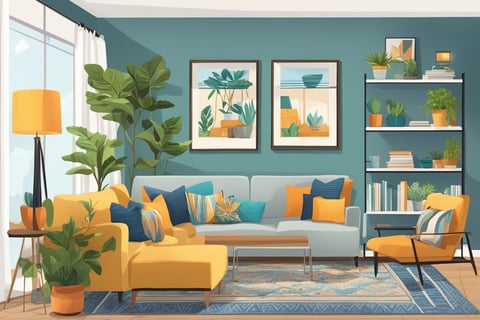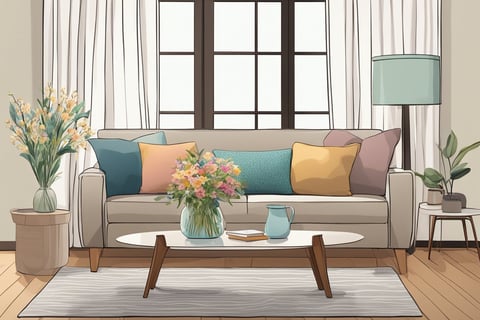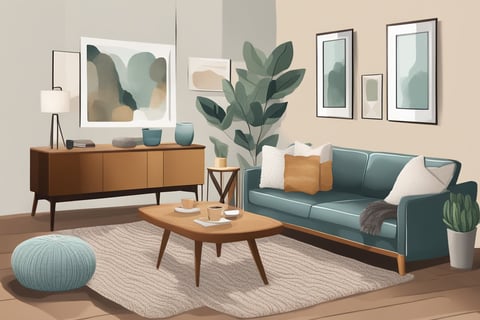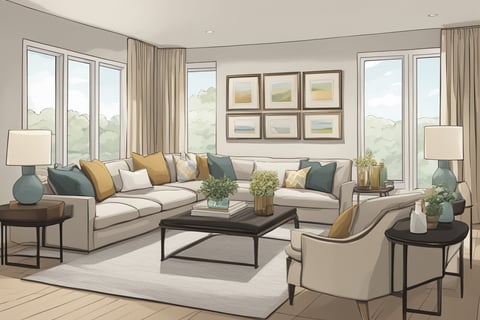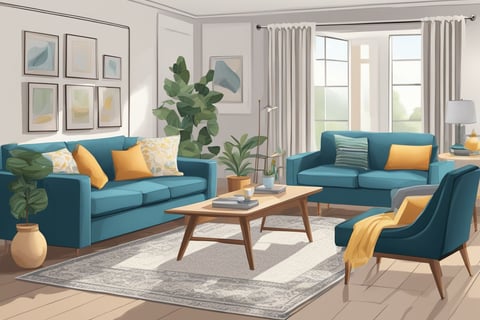5 Easy Ways to Refresh Your Living Room: Simple Updates for a New Look
Give your living room a fresh feel without a complete makeover! This post covers five quick and affordable updates—like swapping out throw pillows, adding stylish new lighting, and rearranging furniture—to instantly elevate the space. Perfect for anyone looking to refresh their home with minimal time and effort, these tips will help you create a welcoming, updated look in no time.
11/12/20246 min read
5 Easy Ways to Refresh Your Living Room: Simple Updates for a New Look
Refreshing a living room doesn't require a complete redesign or major expense. Small changes like updating throw pillows or adding vibrant artwork can significantly alter the mood of the space. Swapping accessories is a quick and easy way to breathe new life into your home.
Textures play a crucial role in enhancing the room's atmosphere. By introducing varied materials like soft blankets or sleek metals, the room gains depth and interest. Plants can also bring warmth and a touch of nature, making the space more inviting.
Adding a few new pieces can achieve a refreshed look without the need for extensive renovations. These simple updates are not only cost-effective but also customizable to fit any style or preference. This approach allows anyone to personalize their living space effortlessly.
Elevate Comfort With Throw Pillows
Throw pillows add comfort and style to any living room. Selecting the right patterns, colors, and textures can transform a space without a full redesign.
Choosing the Right Patterns and Colors
Selecting patterns and colors that complement existing decor enhances the room's visual appeal. Consider the room's dominant hues. If the walls or furniture are neutral, vibrant pillows can inject color and energy.
For a cohesive look, stick to a palette of 2-3 colors. Mixing patterns like stripes with florals can add interest, but balance is key. Too many patterns and hues can create a chaotic feel. Pillows should harmonize with key furniture pieces or artwork.
Mixing Textures for Visual Interest
Incorporating a variety of textures in throw pillows creates depth and interest. Velvet, linen, and knitted fabrics each contribute a unique feel and aesthetic. Combining soft velvets with chunky knits offers both comfort and style.
Textures can add warmth and a sense of coziness. Mixing smooth and rough textures, such as silk with burlap, can maintain a balanced look. It's important to keep the room’s overall texture in mind. Mixing textures helps achieve a visually engaging and inviting space.
Incorporate New Textures
Enhancing a living room with new textures can effectively transform the feel of the space. Utilizing different textiles and incorporating elements like rugs and drapes contributes to a fresh, inviting atmosphere.
Textile Varieties and Combinations
Introducing a variety of textiles is an excellent way to enrich a room's sensory experience. Velvet, linen, and cotton are popular choices for a cozy effect. Combining these with silk or leather can add unexpected flair.
Textile combinations offer versatility. Consider layering through throw pillows and blankets. Velvet cushions can coexist with a knit throw for tactile diversity. Opting for contrasting colors and patterns can further energize the room, subtly changing the overall look without overwhelming the senses.
Mixing natural and synthetic fibers brings out a balanced, sophisticated aesthetic. Cotton provides comfort, while synthetic blends offer durability. This approach allows flexibility in styling and easy maintenance.
Rugs and Drapes as Texture Elements
Rugs and drapes serve as foundational elements in altering a room's texture. A plush wool rug introduces warmth, especially in colder months, while flat-weave rugs are ideal for a minimalistic touch. Choosing patterns and colors for rugs can define or soften the space's character.
Drapes have a similar impact. Velvet or heavy linen adds luxury and helps control light. Sheer fabrics allow a room to feel airier, perfect for sunnier climates. Combining varied drape lengths can also contribute to room dynamics, emphasizing height or elongating walls.
Selecting rugs and drapes thoughtfully enhances both comfort and style, allowing personal expression in the living space without major renovations.
Update Wall Artwork
Refreshing your living room can be achieved by updating wall artwork. This involves selecting appropriate art pieces and possibly creating a gallery wall for visual interest.
Selecting Art Pieces
Art selection begins with understanding the room's style and color scheme. Bold, colorful pieces can add vibrancy, while subtle hues offer a calming effect. Consider art reflecting personal interests or themes, such as landscapes, abstract designs, or portraits. The size of the artwork is critical; larger pieces create focal points, while smaller pieces can complement existing decor.
When selecting art, position and lighting should not be overlooked. Proper lighting enhances colors and details, so placement should ensure adequate exposure to light sources. Rotating artwork occasionally can keep the space feeling dynamic and fresh.
Creating a Gallery Wall
A gallery wall combines multiple art pieces on one wall, allowing for creativity and personalization. Start by planning the layout using paper templates to denote each piece’s position. This helps visualize the arrangement without committing to hammering nails immediately.
Vary sizes, shapes, and frame styles to create visual diversity. Consistency in theme or color can provide cohesion. Balanced spacing between pieces prevents the wall from appearing cluttered, while an asymmetrical layout can offer a modern look. Incorporating mirrors or three-dimensional objects can add depth.
Each piece should be securely attached to ensure safety, particularly if the wall is near heavy foot traffic or used in homes with children. Regular dusting maintains the gallery's clean, inviting appearance.
Add Indoor Plants
Enhancing a living room with indoor plants boosts aesthetics and improves air quality. Selecting suitable plant types and arranging them to fit the space are essential for maximizing their benefits. Proper care ensures they thrive and complement the room's design.
Choosing Plants for Your Space
When selecting indoor plants, it's crucial to consider lighting conditions in the room. Low-light areas are ideal for snake plants or pothos, while succulents and cacti thrive in bright, sunny spots.
Evaluate the room's humidity levels as well. Peace lilies and ferns enjoy higher humidity, making them perfect for certain living areas. Size matters too; large plants like fiddle leaf figs can become focal points, while smaller plants provide subtle accents.
List of Considerations:
Lighting: Shade-loving vs. sun-loving
Humidity: High vs. low tolerance
Space: Large vs. small plants
Plant Care and Placement
Proper care is key to keeping indoor plants healthy. Pay attention to their water requirements; overwatering is a common mistake. Most plants need water only when the topsoil feels dry. Use pots with drainage holes to prevent waterlogging.
Placement also affects plant health. Avoid areas with drafts or direct heat sources like radiators. Rotate plants occasionally for even growth and dust leaves to ensure they can absorb sunlight effectively.
Placement Tips:
Keep away from drafts
Rotate periodically
Dust to maintain leaf health
Regularly check plants for pests and remove any dead foliage to keep them looking vibrant.
Rearrange the Furniture
A simple rearrangement of furniture can invigorate a living room, improving usability and aesthetics. Focusing on a new focal point and optimizing space can significantly enhance comfort and functionality.
Creating a New Focal Point
Establishing a new focal point in the room redirects attention and refreshes the aesthetic. Consider repositioning the sofa to face a window with a view or a fireplace. This can introduce a natural or architectural emphasis to the space.
Incorporating a large piece of art or a striking mirror can serve as an eye-catching element. Pay attention to sightlines from the room's entrance. Ensure that the focal point invites exploration and initiates conversation, welcoming guests with a captivating centerpiece.
Optimizing Space and Flow
Rearranging furniture helps maximize the available space, encouraging better flow. Think about the main pathways used to move through the room. Open and clear these pathways to reduce obstructions and enhance movement.
Experiment with angling furniture pieces, such as orienting chairs slightly toward each other to encourage interaction. Position pieces like side tables and chairs strategically to facilitate conversation and accessibility. Consider removing unnecessary pieces to achieve a minimalist and airy environment.
Balance is key in optimizing flow. Ensuring unity between various elements can elevate both comfort and layout, transforming the living space into a more enjoyable and functional area.
